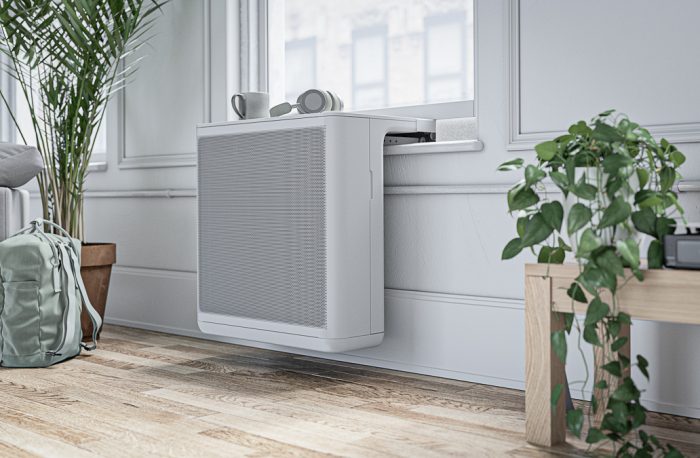Comparing Window Heat Pumps and Ductless Mini-Splits: What’s Best for Your Home?
Understanding Window Heat Pumps and Ductless Mini-Splits
Window Heat Pump: A window heat pump is a compact unit that provides heating and cooling by extracting heat from outside and bringing it indoors, or vice versa, depending on the season. As the name suggests, these units are typically installed in a window and are a common choice for those looking for a temporary or less invasive solution.
Ductless Mini-Split: Ductless mini-splits are more permanent fixtures that provide heating and cooling without requiring extensive ductwork. These systems consist of an outdoor compressor/condenser and one or more indoor air-handling units connected by a small conduit. The indoor units are mounted high on the wall and can be installed throughout the home to provide zoned temperature control.
Key Differences
Installation: Window heat pumps are generally easier and quicker to install than mini-splits since they don’t require drilling through walls to mount indoor units. However, they take up window space, which can be a drawback for those who value natural light or have limited window availability.
Efficiency and Cost-Effectiveness: Ductless mini-splits are renowned for their efficiency. They operate on less power, are more effective at air distribution, and adjust their speed based on the system’s needs, which significantly reduces energy waste. This efficiency translates into lower utility bills over time despite similar initial installation costs to window units.

Noise Levels: One of the standout advantages of ductless mini-splits is their quiet operation. Unlike window units, which can be quite noisy due to the proximity of all mechanical components, mini-splits have their compressor located outside, drastically reducing indoor noise.
Aesthetics and Space Saving: Mini-splits offer a sleek, modern look and take up very little space in the room. Since they mount high on the wall, they blend easily into your home’s decor, unlike window units that can be an eyesore and block window space.
Longevity and Durability: Mini-splits generally have a longer lifespan than window units. Their durability, combined with less intrusive installation and quieter operation, makes them a more permanent solution for temperature control in the home.
While window heat pumps provide a convenient and relatively inexpensive solution for heating and cooling single rooms, there are several downsides that might make them a less favorable investment over time, especially when compared to more advanced systems like ductless mini-splits. Understanding these limitations can help homeowners make a more informed decision about their HVAC investments.
Drawbacks of Window Heat Pumps
Energy Efficiency Limitations: Window heat pumps are generally less energy-efficient than other HVAC systems. They often have lower SEER (Seasonal Energy Efficiency Ratio) ratings, which means they consume more energy to provide the same amount of heating or cooling as higher-rated systems. This inefficiency can lead to higher utility bills, particularly in regions with extreme weather conditions where the heat pump must work harder to maintain comfortable indoor temperatures.
Noise Levels: One significant disadvantage of window heat pumps is the noise. Because the compressor and all mechanical parts are housed within the same unit that sits partially inside the home, these systems can be quite loud during operation. This can be particularly disruptive in quiet environments or in spaces used for sleeping or working.
Security and Aesthetic Impact: Installing a window heat pump requires placing the unit in a window, which can have implications for both security and aesthetics. The presence of the unit in the window can be seen as an eyesore, detracting from the home’s overall curb appeal. Additionally, a window that is partially open to accommodate the unit can pose a security risk, as it may be easier for intruders to access.
be seen as an eyesore, detracting from the home’s overall curb appeal. Additionally, a window that is partially open to accommodate the unit can pose a security risk, as it may be easier for intruders to access.
Limited Heating and Cooling Range: Window heat pumps are generally only effective for heating or cooling the room in which they are installed. Unlike systems with ducts or multiple indoor units that can distribute conditioned air throughout a building, window units have a limited range and do not promote a uniform temperature across different rooms or levels of a home.
Durability and Lifespan: Compared to more robust systems like ductless mini-splits, window heat pumps typically have a shorter lifespan. They are exposed to the elements, which can lead to quicker degradation and more frequent repairs. The units are also more susceptible to damage from external factors like weather and vandalism.
Installation Challenges: Although window units are relatively easy to install, they must be securely mounted and properly sealed to avoid air leaks. Poor installation can result in energy inefficiencies and diminished performance. Additionally, not all windows are suitable for installing a window heat pump, which may limit the feasibility of this option for some homes.
Resale Value: Finally, the presence of window heat pumps can negatively impact the resale value of a home. Prospective buyers might view these as a less desirable feature compared to built-in, more modern HVAC systems, which could ultimately make a home harder to sell.
Why Ductless Mini-Splits are the Optimal Choice for Modern Homeowners
When considering upgrades or installations of new heating and cooling systems, homeowners face many options. Among these, ductless mini-split systems stand out as a particularly advantageous solution. Offering superior energy efficiency, aesthetic flexibility, and impressive longevity, ductless mini-splits are increasingly recognized as the optimal choice for modern homeowners seeking comfort, cost savings, and a seamless fit with their home design. Here’s a deeper look at why switching to a ductless system could be one of the best decisions for your home environment.
Superior Energy Efficiency
One of the most compelling reasons to choose a ductless mini-split system is its exceptional energy efficiency. Unlike traditional forced-air systems that can lose energy through ductwork, ductless mini-splits deliver air directly into different zones of the house, minimizing energy losses. This direct approach makes them more efficient and provides a more environmentally friendly solution to temperature control. The high SEER (Seasonal Energy Efficiency Ratio) ratings of mini-splits further emphasize their ability to operate on less power while providing effective heating and cooling, significantly reducing utility bills over time.
Enhanced Indoor Comfort with Zoned Heating and Cooling
Ductless mini-split systems can control temperatures in individual rooms or zones. Each zone has its own thermostat, allowing you to customize the heating or cooling based on use, which is impossible with traditional HVAC systems. This means you can keep the bedroom cool at night without cooling the entire house or maintain a comfortable temperature in the living room during the day without affecting other areas. Such precise control not only enhances comfort but also reduces energy waste, contributing to the overall efficiency of your home.
Quiet Operation and Minimal Disruption
Another significant advantage of ductless mini-splits is their quiet operation. Since the compressor and condenser components are located outside the home, the noise typically associated with traditional HVAC systems is dramatically reduced. The mini-split indoor units are engineered to operate quietly, ensuring a peaceful indoor environment. This makes ductless systems ideal for environments where noise is a concern, such as bedrooms, home offices, and nurseries.
Aesthetic and Flexible Installation Options
Ductless mini-splits offer sleek, compact designs that can be subtly integrated into any room without compromising the interior aesthetic. Unlike bulky window units or large ductwork, mini-splits require only a small hole in the wall to connect the indoor and outdoor units. This not only preserves the architectural integrity of your home but also provides versatile installation options. Indoor units can be mounted on almost any wall, suspended from the ceiling, or even installed as floor-standing models, offering flexibility that is unmatched by traditional systems.
Longevity and Durability
With proper maintenance, ductless mini-split systems are durable and have a longer lifespan than many traditional air conditioners. Their modern design and advanced technology contribute to fewer mechanical failures, which extends their operational life and ensures that homeowners get more value from their investments.
Making the Choice
Installing a ductless mini-split system is an investment in your home’s future comfort and efficiency. By choosing a mini-split, you’re not just purchasing an air conditioning unit but adopting a customizable, efficient, and sustainable approach to climate control. Homeowners looking to enhance their living space with a reliable, efficient, and discreet heating and cooling solution will find ductless mini-splits an unmatched option.
As you consider upgrading your home’s heating and cooling system, think about how a ductless mini-split system could improve your comfort, reduce your energy bills, and align with your lifestyle needs and aesthetic preferences. Whether renovating, building new, or upgrading your HVAC system, ductless mini-splits offer compelling advantages worth considering. Contact David and Goliath HVAC for your installation needs!


